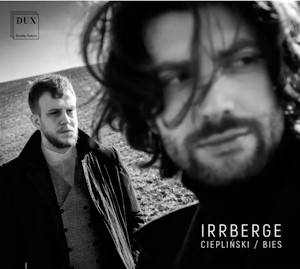
Irrberge
Krzysztof Penderecki (1933-2020)
Prelude for clarinet solo(1987)
Three Miniatures for clarinet and piano (1956)
Claude Debussy (1862-1918)
Sonata for clarinet and piano, L 140 (1917)
Mieczysław Weinberg (1919-1996)
Sonata for clarinet and piano, Op. 28 (1945)
Francis Poulenc (1899-1963)
Sonata for clarinet and piano (1962)
Andrzej Ciepliński (clarinet)
Tymoteusz Bies (piano)
rec. 2021, Concert Hall of the Krzysztof Penderecki European Centre for Music, Lusławice, Poland
Dux 1722 [58]
This is an album with an interesting concept, combining photography with music. I’d imagine this is quite a niche market but it nevertheless colours the playing and choice of repertoire. The photography, authored by Wojciech Grzędziński, focuses on wintry forest scenes and abandoned places, all in black and white. Listening to this on a dull wintry day myself, looking out the window at the grey sky and bare-branched trees, the performances seemed, for the most part, receptive to the concept. How much this really added to the music I am not so sure.
The disc opens with Penderecki’s Prelude for clarinet solo. Its bleak opening allows clarinettist Andrzej Ciepliński to make the most of his appealingly mellow lower register and if the upper part of his range isn’t so luxurious in tone, he nevertheless effectively conveys the more animated parts like bird call echoing through a cold, stark forest. Throughout the album I note a slight lack of willingness to project the music, a reserved intimacy which produces some interesting things but does not convince as well in some pieces as in others. Whether this is the school of playing or a conscious effort to blend with the monochrome imagery I don’t know. I suspect it is a little of both.
The Debussy sonata is intimately scaled, and though there is a nice amount of contrast there were moments when I thought the melodic line needed to be projected more clearly and the piano part handled with more attention to tonal variety. The arrangement for clarinet is tasteful and sensible, changing as little as possible. A couple of harmonics are well translated by Ciepliński with a light, wispy touch. Other things, like the staccato alternatives to pizzicato, obviously impossible to replicate on the clarinet, don’t allow for the same timbral variety as the violin version. The playing is professional and well executed, fitting with the album’s imagery surprisingly well, but when compared with a more authentically French reading in its original instrumentation, such as that of Thibaud and Cortot (EMI CDH 7 63032 2), there is a lack of real character and spontaneity to this reading.
The Weinberg is an interesting piece although very much in the style of Shostakovich which Weinberg’s later music does better to avoid. It starts gloomily with moments of playfulness which are well captured by the duo. I felt that this music responded better to the reserved approach of the soloists but there were, once more, times where I wanted more character to drive the narrative. The second movement, with its beautiful, Klezmer like opening, began to feel meandering towards the end. This is music which, again, for better or worse, fits the mood of the photography though I am left wondering if that has somewhat tempered the tonal and imaginative spectrum of these performances.
I found the Poulenc sonata which follows to be the most successful item on the disc. There is some lovely phrasing here and the intimacy of their approach pays off this time. Humour is not overplayed and Poulenc’s varying moods are beautifully balanced. If the romanza might benefit from more of that added colour and some touches of rubato the closing allegro makes up for it in an idiomatic and charming performance. Ironically this offering is the least fitting with the imagery. Poulenc’s underlying sense of playfulness does not blend with the black-and-white forest or abandoned buildings of the accompanying photography. It’s not jarring, but since the album was made with a concept in mind I wondered if there was a reason for choosing this particular piece. I won’t complain too much, though, as this is really the most winning work on the album.
The just hour-shy disc closes as it started, with some more Penderecki. These miniatures are brief, dissonant yet approachable pieces filled with personality. The opening work, not a minute long, is fun and well-played and the central andante cantabile is approached with a very effective, hushed sonority. There were a couple of times when I wanted the pianist to project the piano’s upper voicing a little more just to avoid it becoming lost in the accompaniment, but this was an enjoyable performance. The finishing allegro ma non troppo could have done with a touch more energy and drive but finishes strongly.
This is a disc which pairs some fine playing with some well-sculpted, if sometimes unimaginative and slightly anonymous performances. The accompanying photography might be of interest to some but, while I thought it an interesting concept, I am not sure if the music really benefits from this added layer, or is slightly underplayed in order to conform to it. The sound is very good with the instruments well captured and well-balanced.
Morgan Burroughs
Help us financially by purchasing from



















